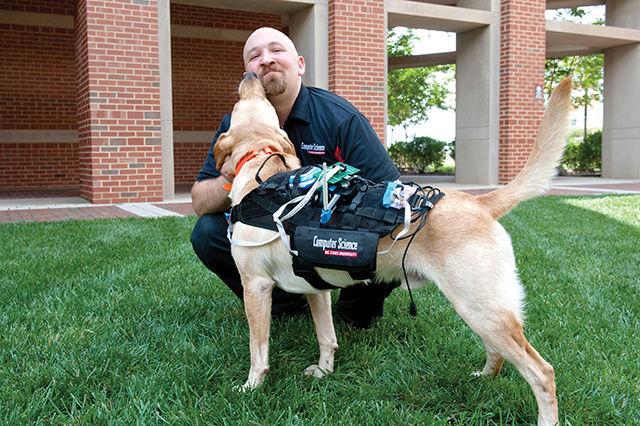Features Focus is a biweekly spotlight highlighting a member of the Wolfpack. Professors, researchers, students past and present, anyone with a great story.
“I can’t explain it, but ever since I was a little kid I’ve always been inexplicably drawn to dogs,” said David Roberts, an assistant professor in computer science engineering.
Roberts has been working with dogs for more than six years. His current research involves a computerized dog harness that monitors dogs and uses the data it collects to train dogs autonomously, with the computer effectively responding to a dog based on the dog’s body language. His own dogs can be heard barking in the background as he discusses behavioral analysis, B.F Skinner and olfactory perception.
“The work that we are doing with the harness is really about laying the foundation for a new field of study in animal-computer interaction,” Roberts said. “The work that we’re doing is focusing primarily on monitoring dogs, what I would refer to as leveraging some of their untrained capabilities. For example, teaching computers how to quickly and accurately discern a dog’s postures so that dogs can operate computers with their postures.”
Roberts said that the harness relies on two types of sensors: positional sensors, similar to the tilt sensors in a smartphone, and physiological monitors, designed to monitor a dog’s heart and respiratory rates.
Using this data, Roberts and his collaborators can get a better understanding of how dogs interact with their environments. The respiratory information is especially important because dogs primarily interact with environments using their noses.
“Understanding how the dog’s respiratory processes relate to different stimuli in an environment will enable us to create more species appropriate interactions with computers,” Roberts said. “If you teach a computer to identify what dogs are doing with their noses the computers can respond and react accordingly.”
Roberts said that this technology has a wide range of applications from improvements in the dog training industry for better performance in military or police use to casual, playful interactions at home with a family pet.
“If you think about the way technology has created new ways for humans to communicate and interact, I envision the right technology having similar implications on the ways that humans and animals interact,” Roberts said. “We are never going to replace the human-dog bond completely but we will provide new avenues for interesting and meaningful interactions.”
Roberts was unable to have a dog of his own when he was a kid because his parents were busy with their careers as college professors and mathematicians. Roberts cited his parents’ careers as a big influence on his career and his way of thinking.
“Many of the explanations about the world that I got growing up were explained using math,” Roberts said. “That is how I started seeing the world as a very young kid. Fast-forward to grad school and I was going through a rough patch when it finally hit me.”
Roberts said he had told himself his entire life that he would eventually get a dog but had not yet done so, prompting him to finally purchase his first dog in grad school, a Shiba Inu named Lucy.
“I like to refer to that as the best bad decision I ever made in my entire life” Roberts said. “I had no idea what I was getting myself into and was not prepared. I started looking for help. How to train dogs. How to interact with them. How to understand them.”
Roberts said that he found an online forum with which he began to discuss and debate dog behavior and training theory with other enthusiasts.
“I found myself in these debates doing what I had been taught to do by my parents, constructing mathematical arguments for why certain things made sense to do with dogs and certain things didn’t,” Roberts said. “It finally hit me that there was probably something a little deeper connecting my understanding of dogs through mathematical modeling and technology.”
When Roberts reached NC State, he contacted Barbara Sherman, a clinical professor of veterinary behavior with the College of Veterinary Medicine . Together, with Sherman and Alper Bozkurt, an assistant professor in electrical and computer engineering, they began what would become six years of animal behavioral research with computers.Roberts currently owns three dogs who often serve as volunteers for research. In addition to Roberts’ own dogs, his research team uses dogs from the community.
“For pilot studies, our own dogs frequently ‘volunteer’ to be subjects,” Sherman said. “Dr. Roberts has a brilliant and enthusiastic yellow Labrador Retriever named Diesel who has become our mascot. Diesel has been trained by Dr. Roberts to be a successful field trial competitor. For the actual clinical studies, we recruit dog owners from the community who bring their dogs to the College of Veterinary Medicine to participate.”
Roberts said that it is very important to him and his team to keep the volunteer dogs happy and the lab environment fun.
“Everything we do is force-free,” Roberts said. “There’s no punishment, there’s no aversive stimuli used. There is no more powerful tool for shaping behavior than reinforcement. It’s very easy to avoid any punishment. It’s not even a consideration. We tell volunteers only feed your dog half your treats in the morning because we make sure they leave with full bellies.”








